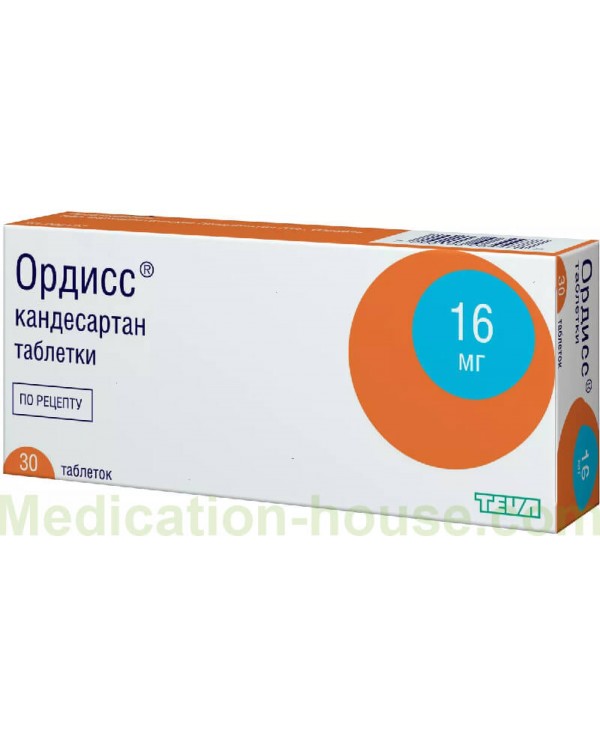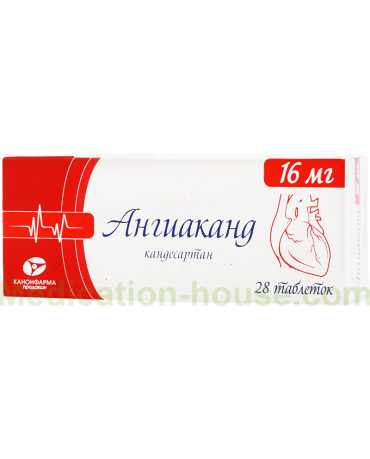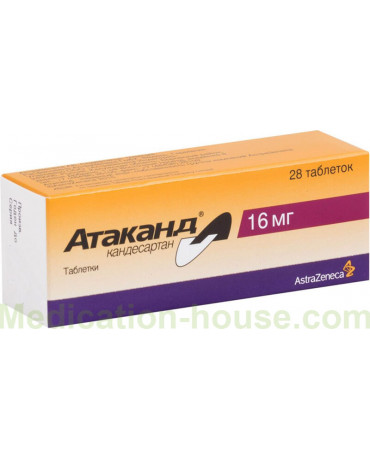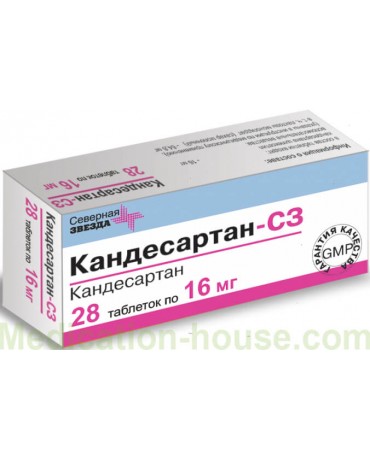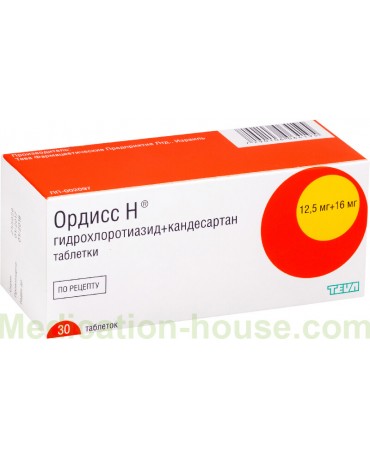Instruction for Ordiss
Reed more and buy Ordiss here
Ordiss is an antihypertensive agent.
Release form and composition
The drug is produced in the form of tablets: capsule-shaped, pink; dosage of 8 mg - with a line on both sides and engraving "8 | C" on one side and "C | 8" on the opposite side; dosage of 16 and 32 mg - with a line and engraving "C | C" on opposite sides, marks on one side and engraving "16" or "32" on the opposite side (5 pcs. in a blister, 6 blisters in a cardboard box; 10 pcs. in a blister, in a cardboard box blisters 3. Each box also contains instructions for the use of Ordiss).
1 tablet contains:
active substance: candesartan cilexetil - 8/16/32 mg;
additional components: poloxamer 188, pregelatinized starch, povidone K30, calcium carmellose, dye iron oxide red (E172), lactose monohydrate, microcrystalline cellulose, magnesium stearate.
Pharmacodynamics
Angiotensin II is the main hormone of the renin-angiotensin-aldosterone system (RAAS), which plays an important role in the pathogenesis of heart failure, arterial hypertension and other cardiovascular pathologies. The main physiological effects of angiotensin II include vasoconstriction, activation of aldosterone production, regulation of the water-electrolyte state, and stimulation of cell growth. These phenomena are associated with the interaction of angiotensin II with type I angiotensin receptors (AT1 receptors).
Candesartan is a selective angiotensin II AT1 receptor antagonist that does not suppress the angiotensin-converting enzyme (ACE), which converts angiotensin I to angiotensin II and breaks down bradykinin, and does not cause the accumulation of bradykinin or substance P. an increase in the level of renin, angiotensin I, angiotensin II and a decrease in the content of aldosterone in the blood plasma.
With candesartan therapy, the occurrence of cough in patients was noted less often than with ACE blockers. The active substance does not interact with receptors of other hormones and does not suppress ion channels involved in the regulation of the activity of the cardiovascular system.
Pharmacokinetics
When absorbed from the gastrointestinal tract (GIT), candesartan cilexetil in the process of ether hydrolysis is rapidly converted into an active substance - candesartan, stably binds to AT1 receptors and slowly dissociates; does not possess agonist properties.
The absolute bioavailability of the drug after oral administration is approximately 40%. The relative bioavailability of candesartan in tablet form when compared with oral solution is approximately 34%, from which it can be concluded that the calculated absolute bioavailability of the tablet form of the agent is 14%. Food intake has no significant effect on the area under the concentration-time curve (AUC), that is, it does not significantly affect the bioavailability of the drug.
3-4 hours after taking Ordiss, the maximum concentration (Cmax) of candesartan is recorded in the blood plasma. With an increase in the dose of the drug within the recommended range, the concentration of the active substance increases linearly. Candesartan binds to blood plasma proteins by more than 99%, the volume of distribution in plasma (Vd) is 0.1 l / kg.
The patient's gender does not affect the pharmacokinetic characteristics of Ordiss.
Candesartan is predominantly excreted from the body unchanged by the kidneys and through the intestines, and only to a small extent is biotransformed in the liver. The accumulation of the active substance in the body is not recorded, the half-life (T1 / 2) is an average of 9 hours.The total clearance of candesartan is approximately 0.37 ml / min / kg, at the same time, the renal clearance is an average of 0.19 ml / min / kg. Renal excretion of the drug is produced by glomerular filtration and active tubular secretion.
When administered orally, radioactively labeled candesartan is excreted by the kidneys and is detected in the feces in the form of candesartan in about 26 and 56% of the administered dose, in the form of an inactive metabolite - 7 and 10%, respectively.
In the presence of mild and moderate functional renal impairment in patients, the AUC and Cmax of candesartan increased by 70 and 50%, respectively, while its T1 / 2 did not change when compared with individuals without renal dysfunction. In patients with severe renal impairment and / or on hemodialysis, the AUC and Cmax of the active substance increased by 110 and 50%, respectively, and its T1 / 2 increased by 2 times.
In the presence of mild and moderate liver dysfunctions in patients, an increase in the AUC of candesartan by 23% was recorded.
Compared with younger patients, in persons over 65 years of age, the AUC and Cmax of candesartan increased by 80% and 50%, respectively. At the same time, the dependence of the hypotensive effect and the incidence of side effects of candesartan on the age of the patients was not found.
Indications for use
arterial hypertension;
chronic heart failure (CHF) and impaired systolic function of the left ventricle (LV) with an LV ejection fraction (LVEF) of no more than 40% - as a drug for additional therapy with ACE inhibitors or in case of intolerance to the latter.
Contraindications
Absolute:
severe liver dysfunction and / or cholestasis;
age under 18;
pregnancy and lactation;
lactase deficiency, lactose intolerance, glucose-galactose malabsorption syndrome;
simultaneous use with direct renin blockers (aliskiren or aliskiren-containing drugs) in patients with diabetes mellitus and / or impaired renal function [with creatinine clearance (CC) below 60 ml / min];
hypersensitivity to any component of the drug.
Relative (you should take Ordiss tablets with extreme caution):
cerebrovascular lesions;
hypertrophic obstructive cardiomyopathy (GOKMP), coronary heart disease (IHD);
hemodynamically significant stenosis of the aortic and mitral valves;
stenosis of an artery of a solitary kidney or bilateral stenosis of the renal arteries;
condition after kidney transplantation (due to lack of data on the use);
primary hyperaldosteronism;
severe renal failure (with CC below 30 ml / min);
hyperkalemia;
hemodialysis;
reduced volume of circulating blood (BCC);
implementation of general anesthesia and surgical interventions (the threat of arterial hypotension due to the blockade of the RAAS).
Ordiss, instructions for use: method and dosage
Ordiss tablets are taken orally, regardless of food, once a day.
Recommended dosage regimen:
arterial hypertension: the initial daily dose is 8 mg, if necessary, a further decrease in blood pressure (BP) should be increased to 16 mg; the maximum antihypertensive effect is noted 4 weeks after the start of the course, the maximum daily dose should not exceed 32 mg; if, while taking the drug, it is not possible to achieve optimal blood pressure control, the therapy regimen should be changed by adding a thiazide diuretic (for example, hydrochlorothiazide) to Ordiss treatment to enhance the hypotensive effect; with hypovolemia, the initial daily dose is 4 mg (½ tablet 8 mg);
CHF: the initial daily dose is 4 mg (½ tablet of 8 mg), the dose is increased to 32 mg or to the maximum tolerated dose by doubling it at intervals of at least 2 weeks; Ordiss is allowed to be taken in combination with other drugs used for CHF, such as diuretics, β-blockers, ACE blockers and cardiac glycosides; elderly people, patients with impaired liver, kidney or hypovolemia do not require adjustment of the initial dose.
In the treatment of arterial hypertension in patients with mild / moderate renal impairment (CC 30–80 ml / min / 1.73 m²), including those on hemodialysis, the initial daily dose of Ordiss is 4 mg (½ tablet of 8 mg). Then it is recommended to titrate the dose taking into account the therapeutic effect of the agent.
In persons with severe renal impairment (CC below 30 ml / min / 1.73 m²) or end-stage renal failure (CC below 15 ml / min), clinical experience with the use of candesartan is limited. In patients of this category, the initial daily dose of Ordiss does not exceed 4 mg; in the future, the dose selection is carried out under the control of blood pressure and regular monitoring of the level of potassium and the concentration of creatinine in the blood serum.
For patients with mild / moderate liver dysfunction, when treating arterial hypertension, it is recommended to take Ordiss in an initial daily dose of 2 mg (¼ 8 mg tablets). If necessary, an increase in the dose is allowed.
Patients with severe hepatic impairment and / or cholestasis are contraindicated in taking the drug due to the lack of clinical experience with its use.
Elderly patients do not need to change the initial dose of Ordiss.
Side effects
Reception of Ordiss may be accompanied by the development of the following adverse reactions (classified in accordance with the recommendations of the World Health Organization: not less than 10% - very often; not less than 1%, but less than 10% - often; not less than 0.1%, but less than 1% - infrequently; not less than 0.01%, but less than 0.1% - rarely; less than 0.01% - extremely rare):
respiratory system: often - rhinitis, pharyngitis, respiratory infections;
cardiovascular system: often - a significant decrease in blood pressure;
nervous system: often - weakness, dizziness, headache;
immune system: extremely rarely - urticaria, skin rash, itching, angioedema;
blood and lymphatic system: extremely rarely - thrombocytopenia, neutropenia, leukopenia, agranulocytosis;
Gastrointestinal tract: extremely rare - nausea;
liver and biliary tract: extremely rarely - increased activity of hepatic transaminases, impaired liver function, hepatitis;
kidneys and urinary tract: often - impaired renal function;
musculoskeletal system and connective tissue: extremely rare - back pain, myalgia, arthralgia;
others: extremely rarely - flushing of the face, exacerbation of the course of gout;
laboratory indicators: extremely rarely - hyponatremia, hyperkalemia, increased creatinine content, decreased hemoglobin levels, hyperuricemia.
Overdose
Based on the analysis of the pharmacological properties of candesartan, it can be assumed that the main symptoms of its overdose may be dizziness and a clinically pronounced decrease in blood pressure. There are descriptions of individual cases of drug overdose (taking up to 672 mg), in which the patient recovered without serious consequences.
If an overdose of the drug is suspected against the background of a significant decrease in blood pressure, symptomatic therapy and monitoring of the patient's condition are required. The patient should be laid on his back, raising his legs, if necessary, it is necessary to increase the BCC, including by intravenous (i / v) infusion of sodium chloride solution (0.9%). Prescription of sympathomimetic agents is also possible. Removal of candesartan from the body by hemodialysis is ineffective.
Special instructions
Against the background of the use of the drug, as well as with therapy with other drugs that inhibit the RAAS, sometimes there may be impaired renal function. With CHF, it is necessary to periodically monitor kidney function, especially in people over the age of 75 and in patients with renal dysfunction. In the case of an increase in the dose, monitoring of the content of potassium and creatinine in the blood should also be carried out.
There are no data on the use of Ordiss for CHF with a creatinine level of more than 265 μmol / l (over 3 mg / ml).
During the period of hemodialysis, blockade of AT1 receptors due to a decrease in BCC and activation of the RAAS can especially affect blood pressure. As a result, patients on hemodialysis are advised to control blood pressure and, based on its indicators, make an individual selection of the dose of candesartan.
Medicines that affect the RAAS (ACE inhibitors) can cause an increase in serum urea and creatinine in the blood against the background of bilateral renal artery stenosis or stenosis of the artery of a single kidney. The same effect can presumably be observed with treatment with angiotensin II receptor antagonists (ARA II).
In the presence of CHF during the period of drug therapy, arterial hypotension may occur. The development of this adverse reaction is also possible in patients with BCC deficiency, for example, when receiving high doses of diuretics. In this case, before starting the course of treatment with Ordiss, it is required to correct the BCC.
During the period of general anesthesia and surgical interventions, patients receiving ARA II may experience a decrease in blood pressure due to RAAS blockade. In some cases, a pronounced decrease in blood pressure is possible, requiring intravenous infusion of fluid and / or vasopressors.
Patients with primary hyperaldosteronism, as a rule, are resistant to treatment with antihypertensive drugs that affect the RAAS; therefore, it is not recommended to prescribe Ordiss to patients in this group.
In patients with CHF receiving Ordiss, the risk of developing hyperkalemia increases. In the presence of CHF during treatment with the drug, it is recommended to monitor serum potassium concentration, especially with the combined use of potassium-sparing diuretics and ACE inhibitors, including amiloride, spironolactone, triamterene and a spironolactone derivative - eplerenone.
Patients suffering from severe CHF, renal lesions, including renal artery stenosis (i.e., with the dependence of vascular tone and renal function on RAAS activity), have a particular susceptibility to drugs that affect the RAAS. Therapy with such agents in these patients is accompanied by such disorders as severe arterial hypotension, oliguria, azotemia and, in rare cases, acute renal failure. The risk of developing these phenomena is not excluded in the treatment of ARA II.
When treating with any antihypertensive drugs, a sudden decrease in blood pressure in patients with ischemic cardiopathy or cerebrovascular lesions of ischemic origin can lead to myocardial infarction or stroke.
Influence on the ability to drive vehicles and complex mechanisms
In view of the possible appearance of undesirable reactions from the central nervous system during treatment with the drug, care must be taken when driving vehicles and controlling other complex and potentially dangerous mechanisms.
Application during pregnancy and lactation
Ordiss is contraindicated for use in pregnant women due to the fact that candesartan has a direct effect on the RAAS and can lead to fetal development disorders or adversely affect the newborn, up to and including death.
If pregnancy occurs against the background of drug therapy, it must be canceled immediately. In the case of planning a pregnancy, a woman should receive adequate treatment that is approved for use during this period.
Babies born to mothers who took Ordiss during pregnancy need careful medical supervision due to the threat of arterial hypotension.
Whether candesartan is excreted in breast milk has not been established, therefore, the drug should not be used during lactation. If necessary, treatment with the mother's drug is required to transfer the child to artificial feeding.
Childhood use
In patients under the age of 18 years, the effectiveness and safety of drug treatment have not been established, as a result of which the drug is not used in pediatric practice.
With impaired renal function
In patients with mild / moderate renal impairment (CC 30–80 ml / min / 1.73 m²), including patients on hemodialysis, the initial daily dose of the drug in the treatment of arterial hypertension should be 4 mg (½ tablet 8 mg). In the future, it is recommended to titrate the dose taking into account the therapeutic effect of the agent.
In persons with severe renal impairment (CC below 30 ml / min / 1.73 m²) or end-stage renal failure (CC below 15 ml / min), clinical experience with the use of candesartan is limited. In such cases, it is required to consider the possibility of taking Ordiss, starting with a dose of 4 mg per day, and then adjusting the dose under the control of blood pressure and regular monitoring of potassium levels and serum creatinine concentrations.
For violations of liver function
For patients with mild / moderate liver dysfunction, when treating arterial hypertension, it is recommended to take the drug in an initial daily dose of 2 mg (¼ 8 mg tablets). If necessary, an increase in the dose is allowed.
Patients with severe liver dysfunctions and / or cholestasis are contraindicated in the drug due to the lack of clinical experience with its use.
Use in the elderly
Elderly patients do not need to change the starting dose of the drug.
Drug interactions
aliskiren, ACE inhibitors, other ARA II: the threat of hyperkalemia, a sharp decrease in blood pressure, renal dysfunction, including acute renal failure, is aggravated; with these combinations, it is required to carefully monitor blood pressure, indicators of renal activity and water-electrolyte metabolism; Candesartan should not be used concurrently with aliskiren or aliskiren-containing agents in persons with diabetes mellitus and / or impaired renal function (CC below 60 ml / min);
isoenzymes CYP2C9 and CYP3A4: no effect on these isoenzymes was found, the effect of candesartan on other isoenzymes of the cytochrome P450 system has not been studied;
warfarin, hydrochlorothiazide, glibenclamide, enalapril, oral contraceptives (ethinylestradiol / levonorgestrel), digoxin, nifedipine: no clinically significant drug interactions have been identified;
other antihypertensive drugs: the antihypertensive effect increases;
dipeptidyl peptidase-4 (DPP-4) inhibitors (vildagliptin): the threat of Quincke's edema increases when these drugs are combined with ACE inhibitors;
potassium preparations, potassium-sparing diuretics; salt substitutes containing potassium; other substances that increase serum potassium levels in the blood (heparin): hyperkalemia may develop;
lithium preparations: the risk of a reversible increase in the serum lithium content in the blood and the development of toxic reactions increases; serum lithium levels should be monitored;
non-steroidal anti-inflammatory drugs (NSAIDs), including selective inhibitors of cyclooxygenase-2 (COX-2), nonselective NSAIDs, acetylsalicylic acid (over 3 g / day): the likelihood of a decrease in the antihypertensive effect of candesartan increases, and the risk of impaired renal function is aggravated , including the development of acute renal failure and increased potassium levels; the combination requires caution, especially in elderly patients.
Terms and conditions of storage
Store in a place protected from moisture at a temperature not exceeding 25 ° C.
Shelf life is 2 years.
Reviews
Reviews about the Ordiss, left on medical websites, are mostly positive. Patients consider the drug to be an effective antihypertensive agent that provides adequate blood pressure control, both during monotherapy and in combination with thiazide diuretics. The advantage of Ordiss is also considered a convenient dosing regimen.
However, some patients also indicate the appearance of side reactions during drug therapy, mainly in the form of dizziness and headaches, because of which they were even forced to refuse to take it.
Terms of sell
You don't need a prescription to buy Ordiss.

